By Kate Cohen
For foodie newbies, the world of sushi can sometimes feel a little intimidating. Whether it’s the idea of eating raw ingredients (trust us, you’ll love it) or the introduction of exotic new flavors, we understand that you may be hesitant to jump right in.
If you’re staring at a sushi menu and feeling lost looking at some unfamiliar words, don’t worry – we’re here to help you decode these exciting new terms. Here is your official Sushi Glossary to help you navigate the exciting world of sushi menus.
Kinds of Sushi
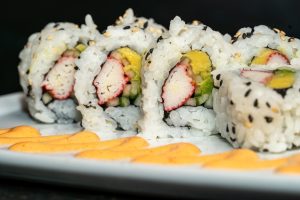 Sushi – The word “sushi” is often used generally in reference to raw fish, but there’s more to the definition than you think. Sushi specifically refers to a dish made with sushi rice, which is prepared with vinegar, sugar, and salt. That rice is then combined with a variety of ingredients like vegetables, seafood, and meat. Sushi is the umbrella term for a variety of styles of preparation, including maki and nigiri.
Sushi – The word “sushi” is often used generally in reference to raw fish, but there’s more to the definition than you think. Sushi specifically refers to a dish made with sushi rice, which is prepared with vinegar, sugar, and salt. That rice is then combined with a variety of ingredients like vegetables, seafood, and meat. Sushi is the umbrella term for a variety of styles of preparation, including maki and nigiri.
Maki – This is likely what you think of when you imagine sushi: neat rolls of rice and thin seaweed wrapped around a variety of tasty ingredients.
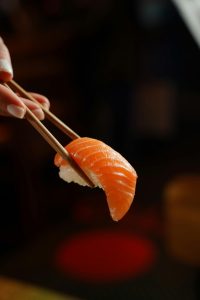
Nigiri – While hearing “sushi” may conjure images of colorful seaweed-wrapped rolls, nigiri looks a little different. Nigiri is premium slices of raw fish, seafood, or protein laid over small beds of sushi rice. Basically, the fish is on top of the rice, rather than rolled inside it.
Sashimi – Similarly to nigiri, sashimi is presented as a thin slice of fresh raw fish. It isn’t served on rice, however, which means it technically isn’t sushi, although it may be served with a bowl of plain rice on the side. Sashimi is all about showcasing the quality of the fish itself.
Norimaki – When you see a sushi roll with seaweed, also known as nori, on the outside, it’s referred to as norimaki. Look a little closer at the word and you’ll see the combination of “nori” (seaweed) and “maki” (roll) right in the name!
Uramaki – If you see the term uramaki on the menu, it means the rice is on the outside of the sushi roll rather than the seaweed. “Ura” means “inside-out,” referring to the backwards preparation of having rice on the outside.
Omakase – Omakase isn’t a specific type of sushi, per se, but rather a sushi experience. Omakase refers to the honor of sitting at the sushi bar, allowing diners to watch and interact with the sushi chef. An omakase sushi menu is left up to the discretion of the chef, so you never know quite what you’ll get! After all, the direct translation of omakase is “I leave it up to you.” Rest assured, you’ll enjoy a meal that highlights the freshest seasonal fish, vegetables, and other ingredients available.
Ingredients
Roe – Those bright, delicate orbs on top of your sushi are likely roe, or fish eggs. These briny bubbles are more than garnish; they also add a dynamic texture and a unique salty flavor to your sushi.
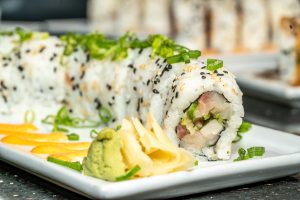 Wasabi – That harmless-looking green condiment beside your sushi packs a pretty wild punch. Wasabi is Japanese horseradish and is used to add a burst of heat and flavor to any sushi.
Wasabi – That harmless-looking green condiment beside your sushi packs a pretty wild punch. Wasabi is Japanese horseradish and is used to add a burst of heat and flavor to any sushi.
Nori – The seaweed commonly used in sushi is known as nori. It’s an edible seaweed pressed into thin sheets before being toasted. You’ll often see it in maki rolls or wrapped around nigiri in a delicate thin strand.
Ponzu – Ponzu is a light, sweet citrus soy sauce that adds a delightful burst of tang to sushi. It’s made with yuzu, a Japanese citrus similar to a lemon.
Unagi – Unagi, or freshwater eel, is a common find on a sushi menu. It has a delicate sweet-and-savory flavor and a light fish-like texture.
Togarashi – If you like things spicy, then togarashi is definitely a word to add to your vocabulary. This mix of seven Japanese spices includes the small, red, and hot Japanese togarashi chili. Togarashi spice mix is a great way to add a little kick to your sushi!
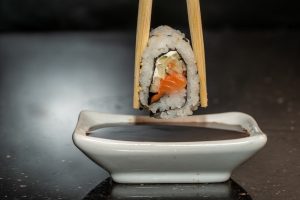
Tamago – While most sushi tends to be savory, tamago (the Japanese word for “egg”) is a lightly sweetened omelet that is sliced and set atop a mound of sushi rice. It’s a delicious way to introduce beginners to the concept of sushi without diving right into seafood or raw fish.
Shoyu – You’re probably familiar with this one; shoyu is the Japanese word for soy sauce.
Techniques
Tempura – Tempura is a thinly battered and deep-fried preparation of sushi ingredients. It typically has a lighter texture than traditional deep-fried food that allows the ingredient itself to still shine with flavor. You may find tempura sushi rolls where some of the ingredients have been fried, or full tempura platters that showcase a variety of proteins and/or veggies.
Tataki – This delicate cooking method marinates fish (and sometimes high-quality beef) to enhance the flavor before searing it on each side. The result is a perfect, light char on the outside and a raw inside that presents two uniquely different textures and flavors in one bite.
Put your Sushi Menu Knowledge to Good Use at Shogun 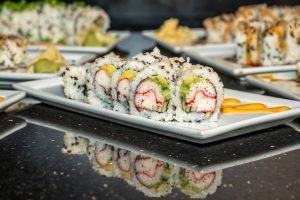
Now that you’re feeling more confident in your sushi menu-reading skills thanks to this sushi glossary, come put them to good use and indulge in some incredible sushi in Orlando at Shogun. Our sushi menu is full of classic and signature dishes that will open your eyes to a world of flavor and thoughtful culinary design. Don’t miss our specialty rolls designed to celebrate the 50th anniversary of Rosen Hotels and Resorts; they’re a delight for the taste buds and the eyes!



